Bride of Frankenstein (1935) - An Illustrated Reference
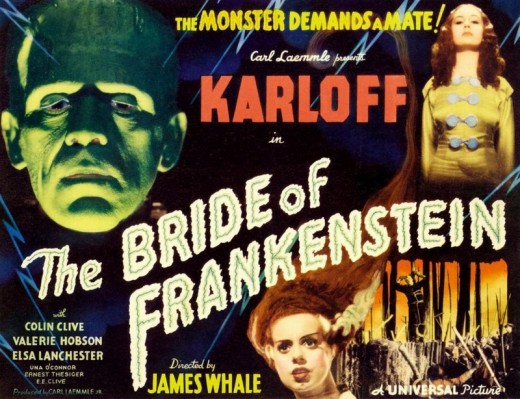

The Bride of Frankenstein was directed by James Whale and premiered on the 22nd April 1935. Starring Boris Karloff, Colin Clive, Valerie Hobson, Ernest Thesiger and Elsa Lanchester. Screenplay by William Hurlbut & John L. Balderston. Music by Franz Waxman. 75mins.
"The monster demands a mate!"
Dr, Pretorius, a friend of Dr. Frankenstein, pays him a visit and asks him to continue his experiments of bringing life to dead tissue. Frankenstein refuses, Pretorius befriends the monster and they kidnap Elizabeth, Frankenstein has no choice but to create a mate for the monster.
James Whale (1889-1957) was born in Worcestershire, England, after gaining some success directing the play Journey’s End on the stage in England he moved to Hollywood where he directed the movie version of Journey’s End (1930), it starred Colin Clive. After the success of Dracula in early 1931 Universal wanted to film Frankenstein and James Whale took the job. It was an even bigger success than Dracula and Whale followed this with The Old Dark House (1932), The Invisible Man (1933) and Bride of Frankenstein (1935).








The Monster: You make man like me
Pretorius: No. Woman friend for you
The Monster: Woman..Friend.. Wife..
Boris Karloff (1887-1969) / The Monster
Born in London, England, Boris Karloff’s success as the monster in Frankenstein (1931) made him a household name around the world and the publicity department only needed to add the name KARLOFF in big letters on movie posters to draw the crowds in.
His films include The Mummy (1932), Scarface (1932), The Old Dark House (1932), The Mask of Fu Manchu (1932), The Black Cat (1934), The Raven (1935), The Invisible Ray (1936), The Walking Dead (1936), Son of Frankenstein (1939), House of Frankenstein (1944), The Body Snatcher (1945), Unconquered (1947), Abbott and Costello Meet Jekyll and Hyde (1953), Grip of the Strangler (1958), The Raven (1963), Die Monster Die (1965), The Sorcerers (1967) and Targets (1968).
Henry: This heart is useless. I must have another, and it must be sound and young.
Colin Clive (1900-1937) / Dr. Henry Frankenstein
Born in St. Malo, France, Colin Clive only appeared in 18 films before his death in 1937 of pneumonia aged just 37. His role as Dr. Frankenstein in the two James Whale classics assured him of screen immortality.
His films include – Journey’s End (1930), Frankenstein (1931), The Key (1934), Jane Eyre (1934), Clive of India (1935) and Mad Love (1935)
Valerie Hobson (1917-1998) / Elizabeth
Born in County Antrim, Ireland, Valerie Hobson was only 17 when she took on the role of Elizabeth in Bride, Mae Clarke played the part in the previous film. Hobson’s films include – Werewolf of London (1935), The Drum (1938), Q Planes (1939), Great Expectations (1946), Blanche Fury (1948) and Kind Hearts and Coronets (1949).
Dr. Pretorius: To a new world of gods and monsters!
Ernest Thesiger (1879-1961) / Dr. Pretorius
Born in London, England, Ernest Thesiger’s films include – The Old Dark House (1932), The Ghoul (1933), The Man Who Could Work Miracles (1936), Henry V (1944), Caesar and Cleopatra (1945), Scrooge (1951), The Robe (1953), Quentin Durward (1955) and The Horse’s Mouth (1958).
Elsa Lanchester (1902-1986) / Mary Shelley / The Bride
Born in London, England, Elsa Lanchester was married to Charles Laughton who had starred in James Whale’s The Old Dark House.
Her films include – The Private Life of Henry VIII (1933), David Copperfield (1935), Rembrandt (1936), The Big Clock (1948), Les Miserables (1952), Witness for the Prosecution (1957), Bell Book and Candle (1958), Mary Poppins (1964), Willard (1971) and Murder by Death (1976).



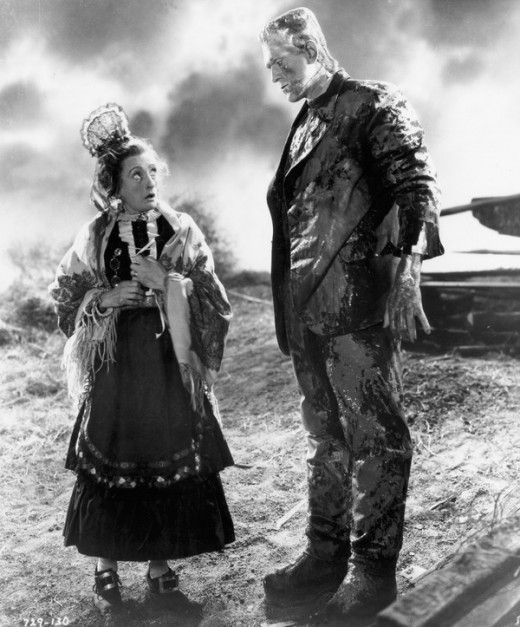

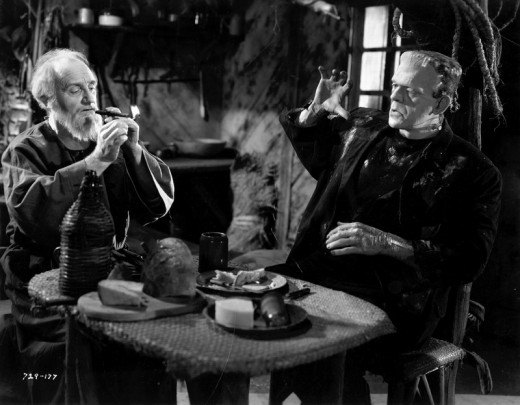




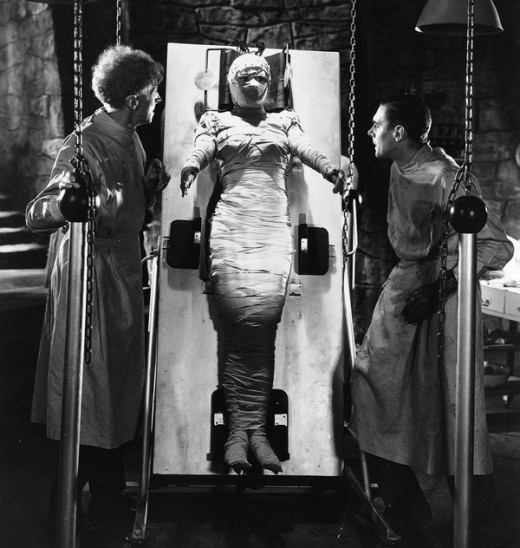




Percy Shelley: I do think it a shame, Mary, to end your story quite so suddenly.
Mary Shelley: That wasn't the end at all. Would you like to hear what happened after that? I feel like telling it. It's a perfect night for mystery and horror. The air itself is filled with monsters.
Lord Byron: I'm all ears. While heaven blasts the night without, open up your pits of hell.
The movie was originally titled The Return of Frankenstein and Brigitte Helm, star of Fritz Lang’s Metropolis, was considered for the role of the Bride.
Claude Rains, who had starred in James Whale’s The Invisible Man, was considered for the role of Dr, Pretorius but he was unavailable.
Elsa Lanchester played both Mary Shelley in the prologue and The Bride, but she is only credited on screen for Shelley, there is a question mark after the credit for the monsters mate.
Lanchester was walking around on stilts to make her look taller as the Bride, the actress was only 5’4” tall.
Boris Karloff was listed fourth on the end credits of Frankenstein (1931) with Colin Clive first, on Bride of Frankenstein its Karloff first, no Boris just ‘Karloff’', and Clive is listed second.
Pretorius: Do you know who Frankenstein is, and who you are?
The Monster: Yes, I know... made me from dead... I love dead... hate living.
Pretorius: You are wise in your generation.
Karloff had reservations about making the monster speak and laugh, he felt it weakened the character, humanising it "if the Monster has any impact or charm, it was because he was inarticulate” Karloff said in an interview. The monster would be mute again in the next film.
The only other time the monster talks in the Universal series is with Bela Lugosi’s voice in Ghost of Frankenstein (1942), when the monster, played by Lon Chaney Jr, has his brain replaced with Ygor’s brain by a descendant of Frankenstein.
Frankenstein: She's alive!
Pretorius: The bride of Frankenstein!
The hissing bride with her scars and hairdo with shock of white became an iconic horror symbol and she would be emulated and parodied in many movies and TV shows to come.
The monster’s encounter with a blind hermit (O.P. Heggie) is one of the most memorable scenes in the film, the blind man teaches the monster to speak and smoke cigars. The monster even sheds a tear for the lonely blind man.
There is a hilarious homage to this sequence in Mel Brook’s comedy classic Young Frankenstein (1974), the monster was played by Peter Boyle and Gene Hackman as the blind hermit.
Henry: But this isn't science! It's more like black magic.
Pretorius: You think I'm mad. Perhaps I am. But listen Frankenstein. While you were digging in your graves, piecing together dead tissues, I, my dear pupil, went for my material to the source of life. I grew my creatures like cultures; grew them, as nature does - from seed. But still, you did achieve results that I have missed. Now think what a world-astounding collaboration we should be, you and I together.
Henry: No! No! No!
The film lapses into fantasy in an amusing sequence where Pretorius shows off his experiments to Henry, seven tiny figures in bottles. The figures are of a king, a queen, an archbishop, a ballerina, a mermaid, the devil and a baby (played by midget Billy Barty who was cut from the finished film). The clever effects were created by special effects wizard John P. Fulton.
In The Old Dark House, Ernest Thesiger as Horace Femm tells his guests “Have some gin, it’s my only weakness”, as an injoke in Bride, Pretorius tells Frankenstein “Do you like gin? It’s my only weakness.” Later he tells the monster “Have a cigar, it’s my only weakness”
Franz Waxman’s excellent score would be re-used in the Buck Rogers and Flash Gordon serials of the 30’s and 40’s.
The sequence at the Gypsy camp replaced another scene that was cut out after preview audiences objected to it. One of the cut scenes showed the monster killing the burgomaster.
Pretorius: Get away from that lever. You'll blow us all to atoms!
In the original ending Henry Frankenstein dies along with Pretorius and the monster when the laboratory explodes. But it was felt that it was too downbeat and it was reshot with the monster letting Henry leave with Elizabeth while telling Pretorius “You stay! We belong dead.”, and pulling the lever. But if you look closely you can still make out Henry inside the lab while it’s exploding.
The line “We belong dead” was #63 in a poll of the 100 greatest movie lines by Premiere magazine in 2007.
Some European countries had problems with the film, they objected to the monster demanding a mate and staring longingly at her bandaged body on the slab, which they felt smacked of necrophilia. A few countries banned it completely.
15 minutes was cut from the film after preview screenings and the body count was reduced after complaints from the censor. The finished film is 75 minutes long.
Bride of Frankenstein cost $400,000 and took 46 days to shoot, it received an Oscar nomination for Best Sound.
Bride was among the films chosen for preservation by the National Film Registry in 1998.
Many critics praised the film, some finding it superior to the original. It is generally regarded as one of the greatest horror films ever made.
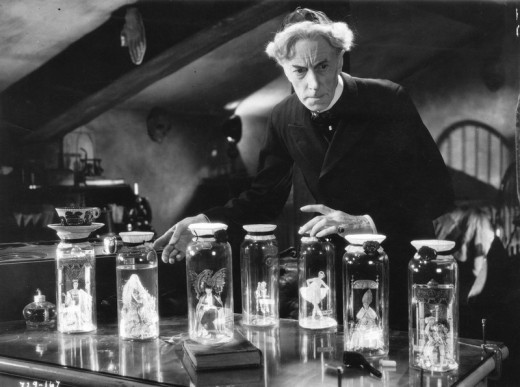


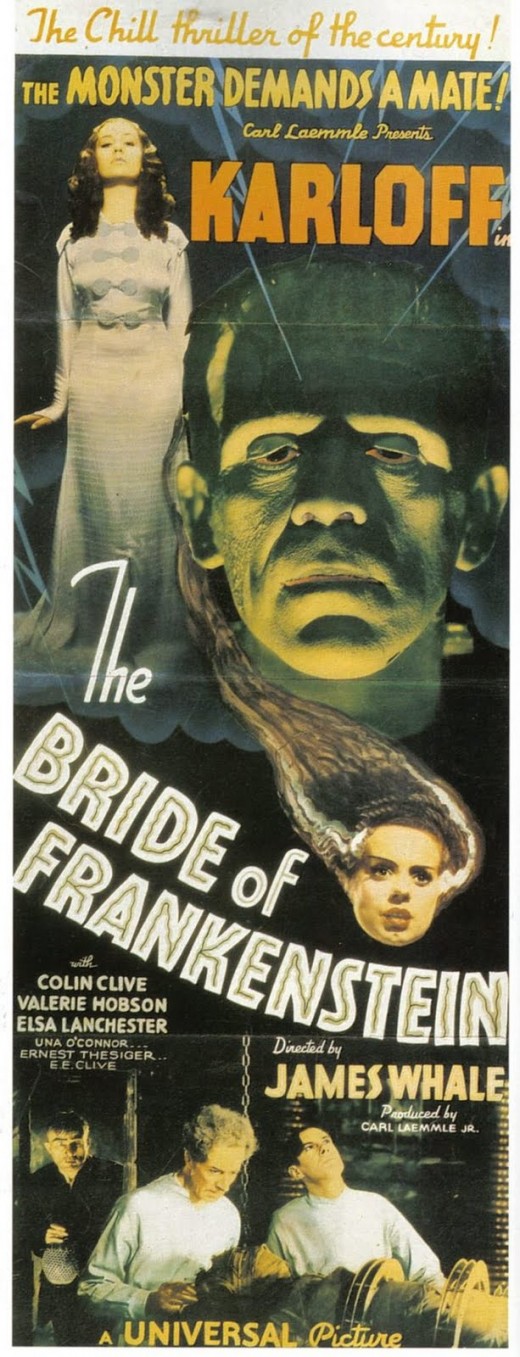
The Critics Wrote –
"Much admired on release for its production values, monster and sense of humour, this is now generally considered the finest of all the Frankenstein movies. Boris Karloff is moving as the monster, and James Whale directs this sequel to his 1931 original with panache. The big problem is that, because so much of it is camp and the monster is so sympathetic, the film isn’t nearly as horrific or frightening as it seemed in the 1930s." (Chris Tookey)
“This caricature by very knowing people is a macabre comedy classic.” (Pauline Kael)
“Indescribably witty, stylish and grotesque; nothing like it has ever been made since.” (Scheuer)
"While this is a major genre film, it is by no means the classic it is claimed to be. By infusing the movie with his own quirky sense of humour, Whale undermines the horror to its detriment." (Alan Frank)
"The most fabulous element of all is the moment of the creation of the She-Monster, a riotous display of unusual camera angles, fast editing, and electrical effects that reaches its climax with the unveiling of the Bride, scored by Waxman with a cacophony of bells." (Carlos Clarens)
"Has to contend with all the difficulties which inevitably confront sequels and it is by no means completely successful in overcoming them. Though there are moments of real horror there are others when the thrills fail to thrill. The Monster is less terrifying, partly because the dawning in him of human qualities arouses sympathy for him." (Monthly Film Bulletin)
"The best of the Frankenstein movies--a sly, subversive work that smuggled shocking material past the censors by disguising it in the trappings of horror. Some movies age; others ripen. Seen today, Whale's masterpiece is more surprising than when it was made because today's audiences are more alert to its buried hints of homosexuality, necrophilia and sacrilege." (Roger Ebert)


© 2012 Steve Lensman








